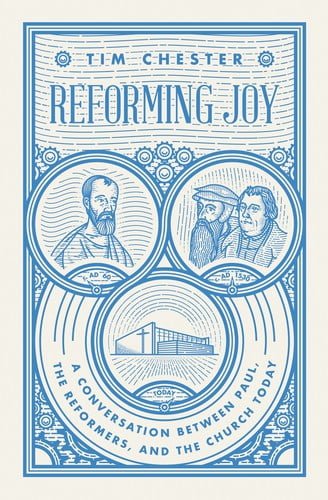⏱️ Estimated Reading Time: 4 min read
Tim Chester’s has a gift for reframing gospel subjects. His book A Meal with Jesus drew my attention to all the times Jesus’ ministry happened in the context of sharing food through ordinary hospitality and miraculous generosity. Suddenly I saw connections I’d never noticed before in my reading of the Gospels.
I’m no Reformation scholar, but I’d always sort of imagined the Reformers as motivated by frustration and even anger, like Jesus overturning the money changers’ tables. In Reforming Joy, Chester claims that it was actually joy that inspired the Reformation. Luther, whose “Ninety-Five Theses” symbolized the start of the Reformation, had experienced teaching from the medieval Catholic Church that didn’t match the “gospel joy” he read about in Galatians, and it was his desire to preserve this joy that inspired his rebellion. In less than 100 pages, Chester connects the joy Paul shared in the letter of Galatians with the same joy Luther rediscovered and that is available to us as well.
Reforming Joy is an accessible introduction to the Reformation. Chester reviews the basic details and notable characters from the movement. But because he is looking at this historical event as a “rediscovery of joy,” even those familiar with these details will appreciate Chester’s pastoral concern that we see joy at the heart of it all (10).
Paul’s letter to the Galatians addresses the incorrect teachings that were tempting believers to desert the gospel. He expresses his concern that “the truth of the gospel be preserved” for his readers (Galatians 2:5). 1,500 years later, Luther would rediscover this preserved truth in Galatians which taught him that Christ kept his “conscience joyful and quiet in the sound, pure doctrine of the Gospel” (45). That joyful assurance was at the heart of his desire for reformation. When Luther’s contemporary William Tyndale published The New Testament in English, he described the gospel as “ good, merry, glad, and joyful tidings, that make a man’s heart glad, and make him sing, dance, and leap for joy” (13).
Chester makes a strong case for joy being at the center of the Reformation; but most of his efforts are focused on making the case for our contemporary need for joy. Chester cheers his readers on towards joy in every chapter. He reminds believers of how easy it is to fall in to a life of religious duty because “we all have a tendency to slip back into viewing God as distant, aloof, and forbidding” (66). Chester reminds us that we cannot control our sin through religious duty and law-keeping because “the law can only expose sin. It can’t stop or cure it” (40). With the gentleness of an experienced pastor, Chester turns our gaze back to Christ and the generous love that redeemed us and makes us children instead of slaves (Galatians 4:7). Chester’s desire is that we will appreciate the historical Reformation and the opportunity for continual reformation because both restore to us the promises of Scripture that offer us the “freedom…to enjoy the best” and experience true joy in our relationship with God (87).
Each chapter begins with a moment from the Reformation, then focuses on a how each chapter of Galatians teaches us about the joy of Scripture, faith alone, the church, adoption, and life in the Spirit. The emphasis of the book is clearly on contemporary readers, with the majority of each chapter spent counseling believers on how to follow the leading of the Spirit. Chester reminds us “the Spirit produces a life that’s superior to law. You can’t have a commandment like ‘Thou shalt not lack joy’…(Instead) the Spirit creates a life no law can express” (92).
I appreciated this refresher course on joy, especially as a tool for better understanding church history and the importance of keeping the gospel pure for future generations. Chester’s choice to include relevant but brief excerpts from Reformation writings adds gravity to the work, reminding us that the concerns of the Reformation are the same concerns we have today. Chester shows us that everything needed for Reformation has always been right there, plainly written in the words of the New Testament and available for all who might need to hear it again.



